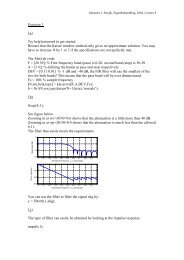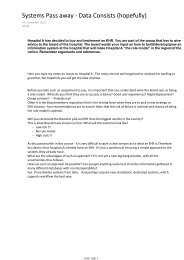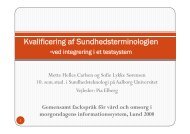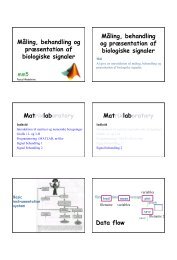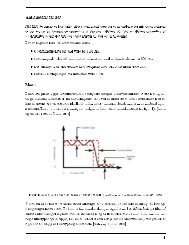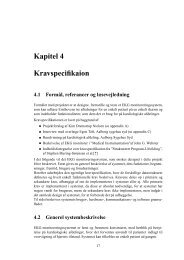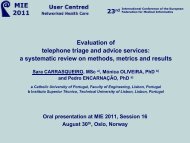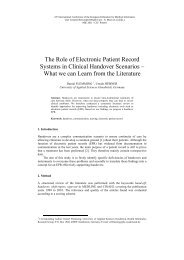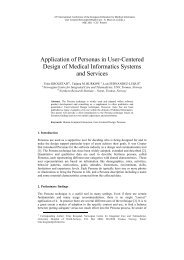ST7 Biomechanics
ST7 Biomechanics
ST7 Biomechanics
Create successful ePaper yourself
Turn your PDF publications into a flip-book with our unique Google optimized e-Paper software.
<strong>ST7</strong> <strong>Biomechanics</strong><br />
- measurement tt technique h i and dsignal i lprocessing i<br />
Aim: to give the student knowledge and understanding of the technology used for<br />
recording and processing and biomechanical signals, and provide skills to use this<br />
knowledge for two- two and three dimensional recording of human movements movements.<br />
Additionally it is the aim to give the student an understanding of the<br />
anatomical/physiological interpretation of biomechanical signals.<br />
Content:<br />
- Sensor types and sensor technology for recording of biomechanical signals<br />
- Methods e ods for o processing p ocess g of o biomechanical b o ec c signals s g s<br />
- 3D kinematics and kinetics<br />
- Kinesiological EMG<br />
- Mechanical efficiency<br />
- Experimental methodology in connection with analysis of human movement<br />
- Practical data collection and analysis<br />
<strong>ST7</strong>_BM_Meas&Sign MM4,2010 1
<strong>ST7</strong> <strong>Biomechanics</strong><br />
- measurement technique and signal processing<br />
Topics – Kinematics – 2D and 3D<br />
• Some historical aspects<br />
• Recording of kinematic signals<br />
• Determination of marker positions<br />
– di direct li linear transformation f i (DLT)<br />
– error in determination of marker positions<br />
• Removal of noise in kinematic signals<br />
– filtering<br />
– determination of cutoff frequency for filtering<br />
• Filtering end effects<br />
<strong>ST7</strong>_BM_Meas&Sign MM4,2010 2
<strong>ST7</strong> <strong>Biomechanics</strong><br />
- measurement technique and signal processing<br />
http://www.hst.aau.dk/~mv/<strong>ST7</strong>_BMsig/<br />
Li Literature:<br />
- <strong>Biomechanics</strong> of the musculo-skeletal system, 2nd ed. editors Nigg,<br />
BM and Herzog W, Wiley 1999.<br />
-<strong>Biomechanics</strong> <strong>Biomechanics</strong> and control of mo movement ement 2nd ed ed. D.A. D A Winter Winter, Wiley- Wile<br />
Inter science Publications 1990<br />
Web resources: http://www http://www.isbweb.org/ isbweb org/<br />
Discussion forum: Biomech-L<br />
<strong>ST7</strong>_BM_Meas&Sign MM4,2010 3
Eadweard Muybridge (1830 – 1904)<br />
• ‘The father of cinematography’<br />
See e.g. http://www.muybridge.nl<br />
<strong>ST7</strong>_BM_Meas&Sign MM4,2010 4
Eadweard dwe d Muybridge uyb dge (1830 ( – 1904) )<br />
- Edward Muybridge, English by birth, immigrates to America in 1851.<br />
In the 1860s he photographs the landscape of the West. In the spring of<br />
1872 Leland Stanford invites him to photograph his horses. Stanford, set<br />
on developing the greatest racing stable in the West, uses every<br />
scientific research to reach his goal. At the time there is disagreement<br />
about whether or not all feet leave the ground at one time during the<br />
gallop.<br />
- In June 1878 six successful series are published on cards as “The<br />
horse in motion." It clearly shows the different stages of the horse's legs<br />
during the run, walk, trot and gallop. For this series Muybridge used 12<br />
cameras and does not use threads but a clockwork to trigger the<br />
sequence of shutters.<br />
<strong>ST7</strong>_BM_Meas&Sign MM4,2010 5
Eadweard Muybridge (1830 – 1904)<br />
- Kinematics of<br />
animal motion<br />
(parrot)<br />
<strong>ST7</strong>_BM_Meas&Sign MM4,2010 6
Eadweard Muybridge (1830 – 1904)<br />
- Kinematics of human performance (one legged jump)<br />
<strong>ST7</strong>_BM_Meas&Sign MM4,2010 7
Kinematics e cs – measurement techniques q<br />
• AAccelerometry l t<br />
• Potentiometers, flexible wire goniometers<br />
(angular information alone)<br />
• Chronocyclography<br />
• Light emitting diodes<br />
• St Stroboscopes b<br />
• Active markers<br />
• Magnetic systems<br />
• Motion film cameras and skin marker<br />
• Video cameras and skin markers<br />
• Video cameras + reflective skin markers<br />
<strong>ST7</strong>_BM_Meas&Sign MM4,2010 8
Accelerometry<br />
Mode of operation<br />
Uni axial – multi axial<br />
<strong>ST7</strong>_BM_Meas&Sign MM4,2010 9
Goniometry<br />
- Potentiometers (3 degrees of freedom (DOF))<br />
- The depicted type require no information about the position the of axes of<br />
rotations of the joint on which it is mounted<br />
<strong>ST7</strong>_BM_Meas&Sign MM4,2010 10
Goniometry<br />
- Flexible wire goniometers (2 DOF)<br />
- strain gauge technology<br />
The flexible wire<br />
Embedded electronics<br />
- htt http://www.biometricsltd.com // bi t i ltd - Cross-section of the flexible wire<br />
Resistances<br />
channel 2, 2 half bridge<br />
wire<br />
Resistances<br />
Channel 1, half bridge<br />
<strong>ST7</strong>_BM_Meas&Sign MM4,2010 11
Goniometry + foot switches – an example application<br />
- Application of flexible wire<br />
goniometers:<br />
Measurement of foot kinematics<br />
- Calcaneal angle in the frontal<br />
plane<br />
- Changes in navicular height<br />
Ref. file : MK030821002<br />
Data file : MK030821005<br />
blue line = average of 10 steps<br />
red line = + +- 1SD 1 SD<br />
calcaneus, frontal plane NB! for all goniometer channels: 0 = standing<br />
30<br />
positive = inversion/supination<br />
20<br />
10<br />
Mean 10.2<br />
Min -0.1<br />
Max 23 23.1 1<br />
+- 0.6 deg<br />
+- 0.7 deg<br />
+ +- 22.1 1 deg<br />
[deg]<br />
[cm]<br />
[V]<br />
0<br />
Calcaneus reference angle = 0 deg<br />
-10<br />
0<br />
navicular<br />
10<br />
heigth g<br />
20 30 40 50 60 70 80 90 100<br />
65<br />
dNavH stance = -3.7+- 0.7 mm<br />
dNavH total = 9.3 +- 0.4 mm<br />
mean NavH = 58.3 +- 0.3 mm<br />
NavH ref = 56 mm<br />
60<br />
55<br />
0 10 20 30 40 50 60 70 80 90 100<br />
10 footswitch<br />
8<br />
6<br />
4<br />
2<br />
Phases: heel,flat heel flat foot, foot forefoot/toe, forefoot/toe swing<br />
Cyclus time = 962 +- 8 ms<br />
Step freq = 1.04 +- 0.01 Hz<br />
Heel = 8 +- 1 % cyclus<br />
Flatfoot = 25 +- 1 % cyclus<br />
Forefoot = 57 +- 1 % cyclus<br />
0 10 20 30 40 50 60 70 80 90 100<br />
0<br />
gait cycle [%]<br />
<strong>ST7</strong>_BM_Meas&Sign MM4,2010 12
Chronocyclography<br />
C o ocyc og p y<br />
Chronocyclograph (approx. 100 Hz)<br />
- Shoulder and hand movement<br />
during gright g hand straight g ppunch<br />
- light source mounted on the<br />
shoulder and the hand<br />
(MV master thesis 1987)<br />
-setup<br />
- recording<br />
max. velocity<br />
<strong>ST7</strong>_BM_Meas&Sign MM4,2010 13
Light g emitting e g diodes d odes<br />
Weight lifting : clean & jerk technique<br />
+ flash 2. -flash<br />
44.<br />
1.<br />
55.<br />
3.<br />
- Still picture camera with open<br />
shutter<br />
- Flash<br />
- 50 Hz light emitting diodes<br />
mounted on the end of the<br />
barbell and on the floor<br />
<strong>ST7</strong>_BM_Meas&Sign MM4,2010 14
Stroboscopes<br />
S oboscopes<br />
- for quantitative measurements<br />
See e.g.<br />
http://www.elmed-stroboscopes.com/<br />
- for illustrative purposes<br />
<strong>ST7</strong>_BM_Meas&Sign MM4,2010 15
Motion o o film cameras c e s – intermittent pin p<br />
light : 8 kW !<br />
16 mm film 500 frs s-1 16 mm film, 500 frs s<br />
<strong>ST7</strong>_BM_Meas&Sign MM4,2010 16
Motion o o film cameras c e s – rotating gpprism<br />
For high speed cinematography products see e.g.<br />
http://www http://www.photosonics.com/<br />
photosonics com/<br />
<strong>ST7</strong>_BM_Meas&Sign MM4,2010 17
Motion o o film technology ec o ogy – film digitization g<br />
Manual:<br />
- PProjection j ti of f each h picture i t frame f onto t a digitizing di iti i<br />
tablet and manual digitization (custom made setup)<br />
Semi automatic:<br />
- Contrast enhanced field of view<br />
dduring i the h recording di<br />
- Frame-by- frame transfer of film to<br />
video (ElmoTM TRV-166)<br />
- Automatic tracking in video pictures<br />
bby PPeak k PPerformance f TTechnologies h l i TM<br />
motion capture system software<br />
http://www.peakperform.com<br />
<strong>ST7</strong>_BM_Meas&Sign MM4,2010 18
Magnetic sensors and systems<br />
11. Th They measure roll, ll pitch it h and d yaw and d X,Y,Z X YZ<br />
positions of segments<br />
2. Electromagnetic induction<br />
3. The transmitter is a triad of electromagnetic g<br />
coils, that emits the magnetic fields. The<br />
transmitter is the system’s reference frame.<br />
4. The receiver is a small triad of<br />
electromagnetic l t ti coils, il that th t detects d t t the th<br />
magnetic field emitted by the transmitter and<br />
the position and orientation is measured as<br />
the receiver is moved<br />
Positive: The body is ‘transparent’, real time<br />
recording<br />
NNegative: ti Obtrusive, Obt i rather th low l accuracy,<br />
sensitive to ferro-magnetic objects<br />
Fasttrack (120 Hz max.)<br />
h http://www.polhemus.com<br />
// lh<br />
Other systems:<br />
Flock of birds TM<br />
http://www.ascension-tech.com/<br />
<strong>ST7</strong>_BM_Meas&Sign MM4,2010 19
Optoelectronic systems<br />
– with active markers<br />
Optotrack PolarisTM Optotrack Polaris<br />
1. Markers consists of light emitting diodes<br />
(LED’s). ( )<br />
2. Up to three marker clusters.<br />
3. Time multiplexing for the markers 450 Hz<br />
or 750 Hz.<br />
44. PPower tto th the markers k is i provided id d through th h<br />
cables!<br />
5. No tracking – real time recording<br />
6. Very yhigh g accuracy y( (0.1 mm X,Y) , ) and 0.15<br />
mm (Z, depth). http://www.ndidigital.com<br />
Other (older) systems:<br />
Watsmart TM<br />
Selspot II TM<br />
<strong>ST7</strong>_BM_Meas&Sign MM4,2010 20
Video technology<br />
– with reflective markers and automatic detection<br />
1. Reflective markers are mounted on the target<br />
object.<br />
2. The camera emits infrared (IR) flashes from IR-<br />
diodes synchronized with the camera shutter. shutter<br />
3. In each ‘picture frame’ the camera records the<br />
reflected IR-light from the markers over a period<br />
determined by the shutter speed.<br />
4. The picture information is lost and only the bright<br />
spots corresponding to reflected light from the<br />
markers are ‘seen’ by the cameras.<br />
55. The video pictures are digitized. digitized<br />
6. The firmware in the cameras identifies the bright<br />
pixel clusters corresponding to the marker<br />
reflections and calculates the x-y coordinates of<br />
the centroid.<br />
7. The 2D camera coordinates are sent to a PC<br />
through a high speed serial connection. For further<br />
processing<br />
ProReflex cameras (1 1000 frs s )<br />
- ProReflex cameras (1 – 1000 frs s -1 )<br />
http://www.qualisys.se<br />
Other manufacturers:<br />
Vicon TM (http://www.oxfordmetrics.com)<br />
( p )<br />
Motion Analysis TM Corp.<br />
(http://motionanalysis.com)<br />
Elite TM (http://www.bts.it)<br />
Peak Performance TechnologiesTM processing. Peak Performance TechnologiesTM (http://www.peakperform.com)<br />
<strong>ST7</strong>_BM_Meas&Sign MM4,2010 21
Determination of marker positions in 3D<br />
- issues of accuracy<br />
• Accuracy of the calibration frame<br />
• Quality of the DLT reconstruction<br />
• Quality of the lenses<br />
• Deformation of the film in the image plane<br />
• Resolution of the light sensitive chip<br />
<strong>ST7</strong>_BM_Meas&Sign MM4,2010 22
Determination of marker positions in 3D<br />
- di direct t linear li transformation<br />
t f ti<br />
- provides a linear relationship between two dimensional coordinates (x,y) of<br />
a marker i = (1,…..,m), the cameras (n cameras (1,….,j)) and the coordinates<br />
on the film and its location in the three dimensional space.<br />
<strong>ST7</strong>_BM_Meas&Sign MM4,2010 23
Determination of marker positions in 3D<br />
- direct linear transformation<br />
- A calibration lib ti of f N points i t with ith known k coordinates di t xr,yr,zr ( (r = 1,….,N) 1 N) iis<br />
used for determination of coefficients akj for each camera<br />
- 11 coefficients have to be determined<br />
- each camera is described by two equations<br />
- as long as a minimum of two cameras are used<br />
6 calibration points gives therefore 12 equations<br />
- the over-determined over determined of system of linear equations is solved by least<br />
squares technique<br />
- the solution is not unique since the measurements<br />
are not perfect and the solution is approximated<br />
by minimizing errors (∆j) i.e. the ‘norm of residuals’<br />
(NR) ( ) defined as:<br />
(N=12)<br />
<strong>ST7</strong>_BM_Meas&Sign MM4,2010 24
Marker positions<br />
- potential sources of error<br />
• Errors implicit in the direct linear<br />
transformation<br />
<strong>ST7</strong>_BM_Meas&Sign MM4,2010 25
Determination of marker positions in 3D<br />
- lens correction<br />
Correction term in the DLT<br />
Calc.<br />
<strong>ST7</strong>_BM_Meas&Sign MM4,2010 26
Determination of marker positions in 3D<br />
- potential sources of error<br />
• errors due to relative camera placement<br />
- cameras should be placed at<br />
angle near 90o and not less than<br />
60o 60<br />
<strong>ST7</strong>_BM_Meas&Sign MM4,2010 27
Errors in rigid body motion<br />
-using i markers k<br />
- marker movement (skin ( mounted markers) )<br />
- errors due to relative marker movement<br />
(movement of markers in relative to each other)<br />
- can be solved by using marker attachment systems/frames<br />
<strong>ST7</strong>_BM_Meas&Sign MM4,2010 28
Errors in rigid body motion<br />
-using i markers k<br />
- absolute marker movement<br />
(movement ( of markers in relation<br />
to anatomical landmarks)<br />
- can bbe solved l db by using i bone b<br />
fixed markers<br />
<strong>ST7</strong>_BM_Meas&Sign MM4,2010 29
Using bone mounted markers<br />
- for more accurate kinematics<br />
KK-wires i 2 mm diam. di<br />
Marker cluster<br />
(19 mm reflective<br />
markers)<br />
Insertion pin p<br />
(tibia, calcaneus)<br />
Insertion pin<br />
(navicula)<br />
90 deg adapter<br />
(navicula)<br />
Calcaneus<br />
PPoint i tof fi insertion ti<br />
(navicula) - Ready to go<br />
Local anaesthesia<br />
(calcaneus)<br />
X-ray guided insertion<br />
Insertion depth 20-25 mm<br />
Tibia<br />
Navicula<br />
(Voigt, Christensen and Simonsen XX ISB Conference 2005 )<br />
<strong>ST7</strong>_BM_Meas&Sign MM4,2010 30<br />
30
Sampling S p g frequency eque cy<br />
<strong>ST7</strong>_BM_Meas&Sign MM4,2010 31
Kinematic e cs signals g s<br />
<strong>ST7</strong>_BM_Meas&Sign MM4,2010 32
Kinematic e cs signals g s – and noise<br />
<strong>ST7</strong>_BM_Meas&Sign MM4,2010 33
Kinematics e cs – effects of high g frequent q noise<br />
<strong>ST7</strong>_BM_Meas&Sign MM4,2010 34
Kinematic e cs signals g s – smoothing gtechniques q<br />
e.g.<br />
• least squares polynomial fitting<br />
• spline interpolation<br />
• filtering<br />
<strong>ST7</strong>_BM_Meas&Sign MM4,2010 35
Kinematics e cs – smoothing gtechniques q<br />
<strong>ST7</strong>_BM_Meas&Sign MM4,2010 36
Kinematic e cs signals g s – filtering gand cut off frequency q y<br />
<strong>ST7</strong>_BM_Meas&Sign MM4,2010 37
Kinematics e cs – smoothing gtechniques q<br />
• for most applications a 2nd order digital Butterworth filter,<br />
performed f d bidirectionally bidi i ll has h proven to be b adequate. d The Th procedure d<br />
gives a ’zerolag 4th order Butterworth filter’<br />
<strong>ST7</strong>_BM_Meas&Sign MM4,2010 38
Kinematics e cs – smoothing gtechniques q<br />
• determination of the cutoff frequency for the filter<br />
– Frequency analysis (Fast Fourier Transform)<br />
– A residual analysis<br />
filtering frequency<br />
<strong>ST7</strong>_BM_Meas&Sign MM4,2010 39
Kinematics e cs – calculation of velocity y and acceleration<br />
- velocity<br />
- acceleration<br />
or<br />
<strong>ST7</strong>_BM_Meas&Sign MM4,2010 40
Segment Seg e and d Jo Joint angles g es – 2D<br />
Segment angles:<br />
- in relation to horizontal<br />
- counter clockwise = positive<br />
Joint angles: e.g.<br />
<strong>ST7</strong>_BM_Meas&Sign MM4,2010 41
Opgaver pg<br />
1. Signalfil : DJ_toe_marker.txt, en manuelt digitaliseret 2D-koordinat (i m) af 5. metatarsalled<br />
filmet med mekanisk filmkamera med 500 Hz i sagittalplanet.<br />
- implementer en Matlab-funktion, der filtrerer med et 4. ordens Butterworth filter med en cut off<br />
frekvens på 6 Hz og g plot signalet g for den filtrerede y-koordinat y ovenpå det rå signal g for samme<br />
koordinat. Bemærk forskellen mellem det rå og det filtrerede signal i ved slutningen af signalet<br />
for y-koordinaten. Hvad skyldes denne forskel.<br />
- Lav en Matlab – rutine der løser dette problem med ’end effects’.<br />
- Giv et kvalificeret bud på hvilken cutoff frekvens, der skal bruges til filtrering af signalerne for<br />
hhv hhv. x og y koordinaterne<br />
koordinaterne.<br />
- Hvorledes vil du afgøre om de cutoff frekvenser du har valgt er i orden m.h.t. til videre<br />
kinematisk analyse?<br />
2. Signalfil g : kdat.mat, , 3D-koordinater af markører ø på p venstre ben under et fodboldspark p (optaget ( p g med<br />
ProReflex med 240 Hz, angivet i mm). (m-fil (kick_input.m) medfølger med beskrivelse af<br />
koordinaterne i datafilen (kin_dat.mat). XZ-planet svarer til sagittal planet. Signalerne er ikke<br />
filtrerede.<br />
- forsøg at tegne et såkaldt stick-diagram af bevægelse for at visualisere bevægelsen, der sparkes<br />
fra venstre måde højre)<br />
- beregn knævinklen i xz planet og udtryk den som anatomisk vinkel (0 grader er strakt ben og<br />
fleksion er positiv)<br />
- beregn hoftevinklen i xz- planet og udtryk den som anatomisk vinkel (0 grader er strakt ben og<br />
fleksion er<br />
- beregn knævinkel- og hoftevinkelhastigheder og plot dem i samme koordinatststem som<br />
funktion af tiden<br />
- Hvilke problemer kan der opstå når en hastighed beregnes simpelt med finite differences ( (x 1x<br />
2)/dt )?<br />
Data findes på http://www.hst.aau.dk/~mv/<strong>ST7</strong>_BMsig/Litt<br />
<strong>ST7</strong>_BM_Meas&Sign MM4,2010 42



